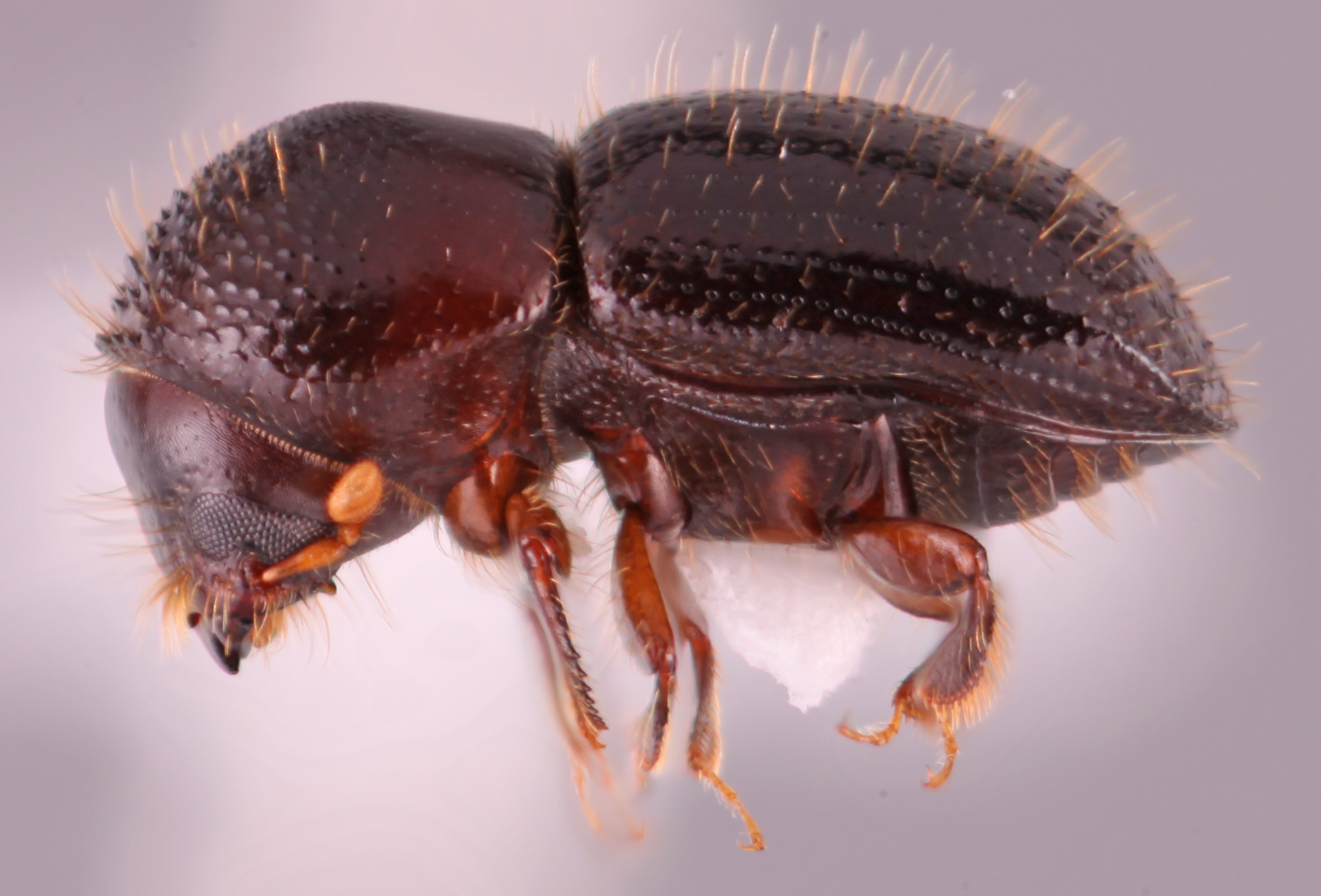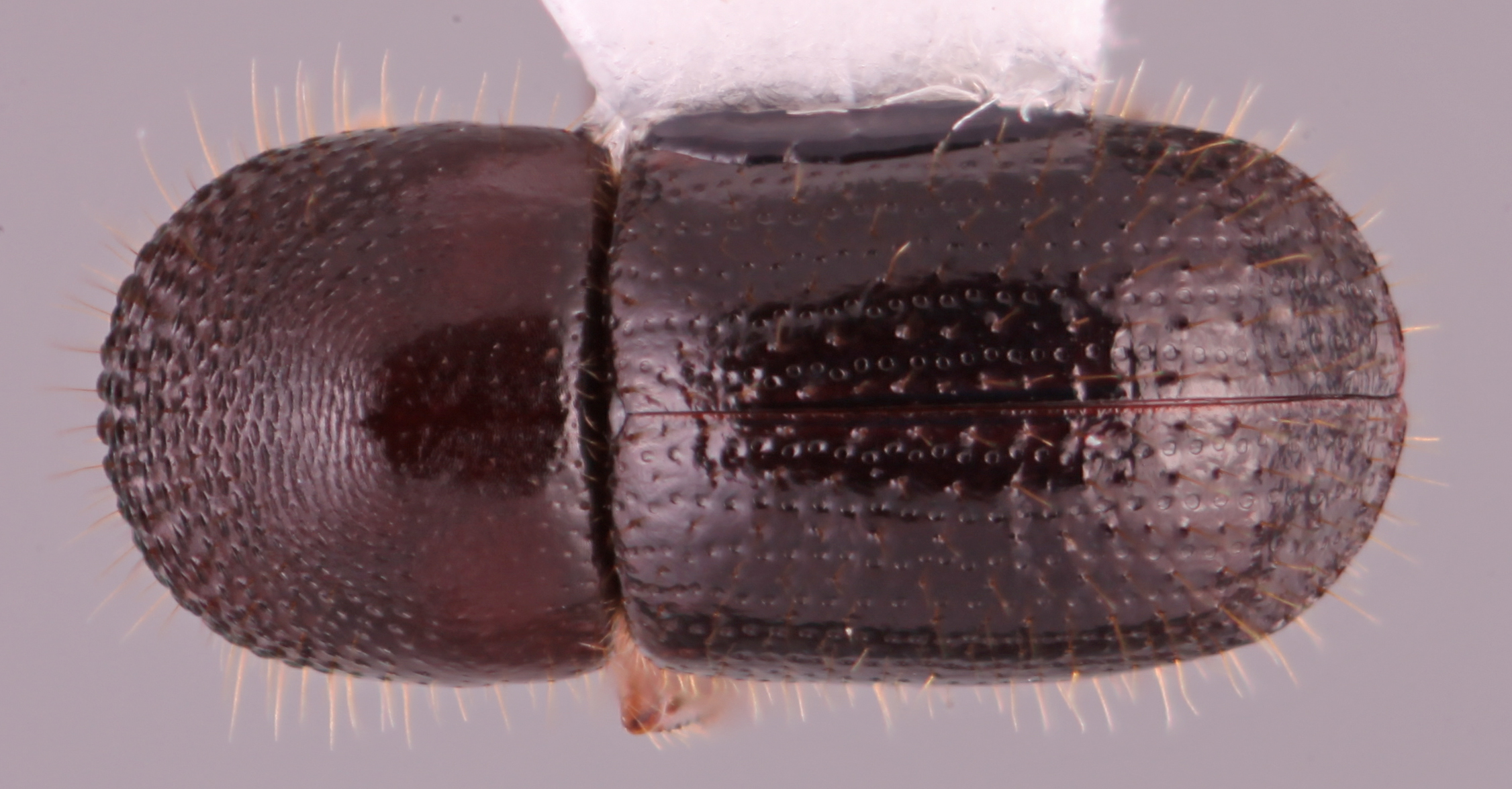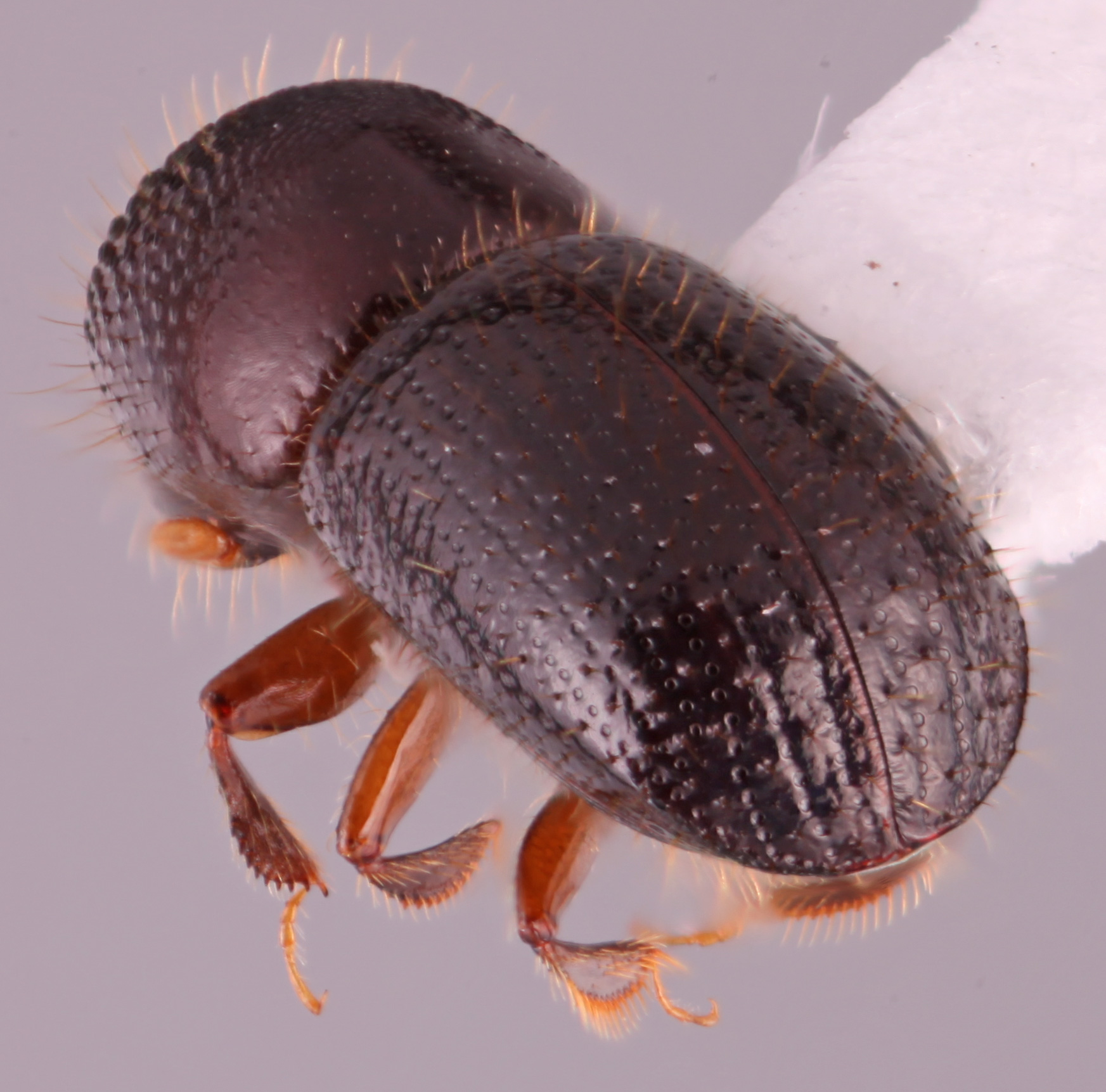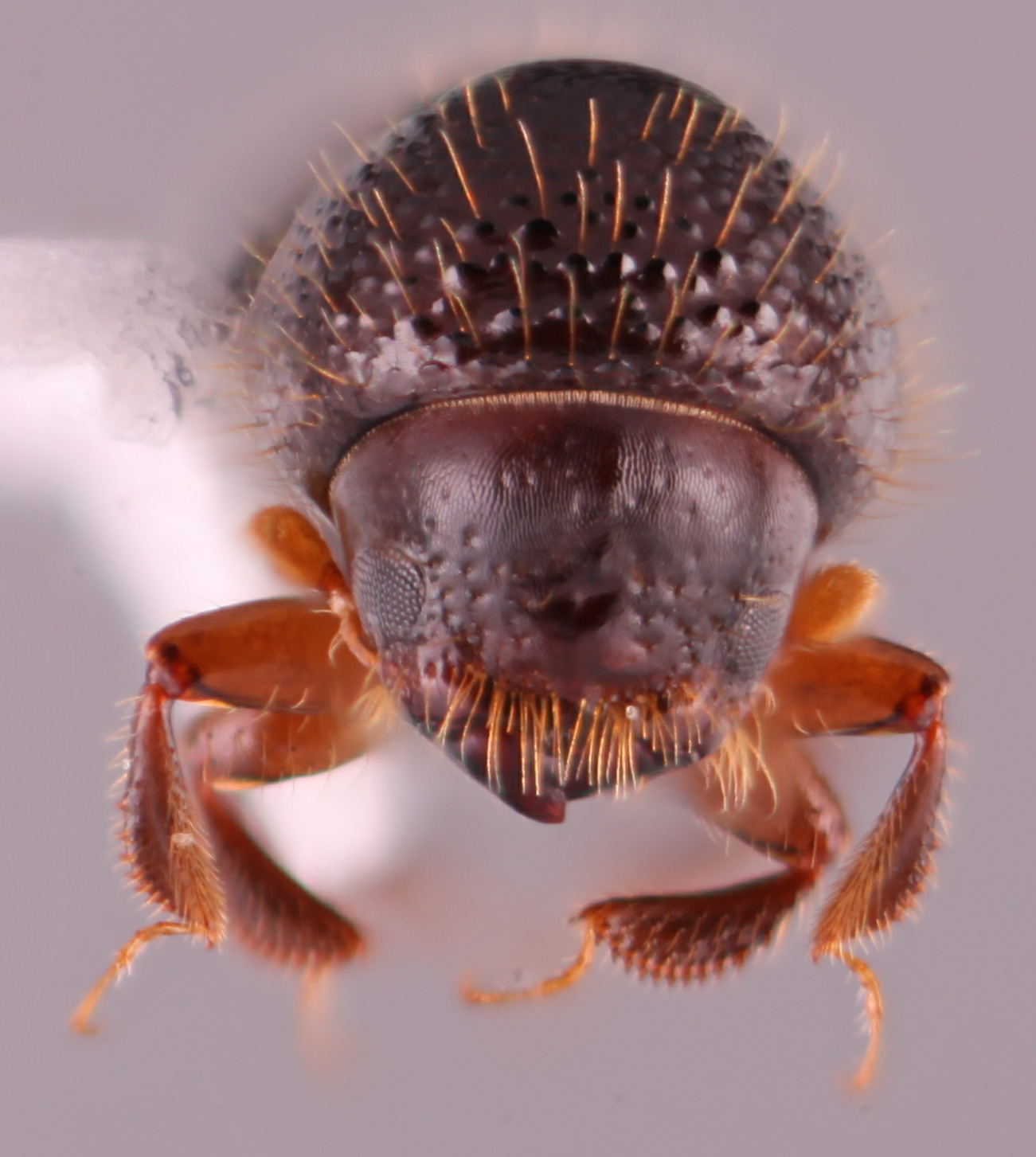Euwallacea fornicatus
|
Euwallacea fornicatus lateral; S.M. Smith |
|
Euwallacea fornicatus dorsal; S.M. Smith |
|
Euwallacea fornicatus declivity; S.M. Smith |
|
Euwallacea fornicatus frontal; S.M. Smith |
Taxonomic history
Xyleborus fornicatus Eichhoff, 1868b: 151.
Euwallacea fornicatus (Eichhoff): Wood, 1989: 173.
Synonyms
Xyleborus fornicatus fornicatus Eichhoff, 1868b: Beeson, 1930: 234.
Xyleborus tapatapaoensis Schedl, 1951b: 152. Wood, 1989: 173.
Xyleborus whitfordiodendrus Schedl, 1942a: 189. Wood, 1989: 173; Smith et al., 2019: 6.
Diagnosis
2.6−2.7 mm long (mean = 2.66 mm; n = 5); 2.25−2.36 times as long as wide. This species is distinguished by the pronotumpronotum:
the dorsal surface of the thorax
basic (type 2) when viewed dorsally, anterioranterior:
the front or forward; opposite of posterior margin appearing rounded; elytralelytral:
margin appearing rounded; elytralelytral:
pertaining to the elytra
declivitydeclivity:
downward slope of either the pronotum or elytra
 rounded; declivitaldeclivital:
rounded; declivitaldeclivital:
pertaining to the elytral declivity
face convexconvex:
appearing rounded ; protibiaprotibia:
; protibiaprotibia:
tibia of the first pair of legs
outer margin rounded with 8 or 9 socketed denticlesdenticle:
a small tooth, the sides of which are equal and the tip is above the middle of the base , denticlesdenticle:
, denticlesdenticle:
a small tooth, the sides of which are equal and the tip is above the middle of the base small, their sockets small; declivitaldeclivital:
small, their sockets small; declivitaldeclivital:
pertaining to the elytral declivity
surface shiningshining:
appearing glossy or bright in luster; referring to a surface that is polished and reflects light well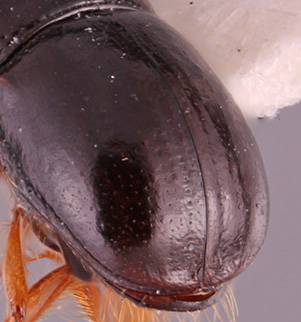 ; interstriaeinterstria:
; interstriaeinterstria:
longitudinal spaces along the elytra between the striae, which is not as<br />
impressed and bear smaller punctures.
 bearing sparse small granulesgranule:
bearing sparse small granulesgranule:
a small rounded protuberance, like grains of sand
 , posterolateralposterolateral:
, posterolateralposterolateral:
relating to end of the side part/portion
 margin costate. This species is nearly identical to E. malloti and E. n. sp. 5 and can be separated by the elytralelytral:
margin costate. This species is nearly identical to E. malloti and E. n. sp. 5 and can be separated by the elytralelytral:
pertaining to the elytra
bases rounded and posterolateralposterolateral:
relating to end of the side part/portion
 declivitaldeclivital:
declivitaldeclivital:
pertaining to the elytral declivity
costacosta:
elevated ridge that is rounded at its crest, not necessarily with sharp appearance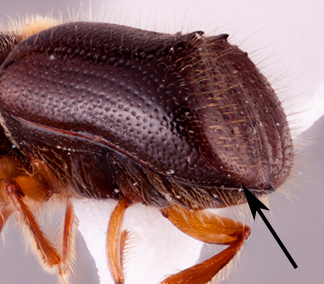 carinate and never granulategranulate:
carinate and never granulategranulate:
pertaining to a coarse, grainy surface texture
 .
.
This species is part of the Euwallacea fornicatus species complex, and the most reliable method to ensure accurate identification of these species is through generation of COI barcoding sequences (Gomez et al. 2018bGomez et al. 2018b:
Gomez DF, Skelton J, Steininger MS, Stouthamer R, Rugman-Jones P, Sittichaya W, Rabaglia RJ, Hulcr J. 2018b. Species within the Euwallacea fornicatus (Coleoptera: Curculionidae) complex revealed by morphometric and phylogenetic analyses. Insect Systematics and Diversity 2(6): 2, 1-11. https://doi.org/10.1093/isd/ixy018, Smith et al. 2019Smith et al. 2019:
Smith SM, Gomez DF, Beaver RA, Hulcr J, Cognato, AI. 2019. Reassessment of the species in the Euwallacea fornicatus (Coleoptera: Curculionidae: Scolytinae) complex after the rediscovery of the ldquo;lostrdquo; type specimen. Insects 10: 261. https://doi:10.3390/insects10090261). Gomez et al. (2018b; figure 1) provide morphological characters for separating the species based on measurements of elytralelytral:
pertaining to the elytra
length (lateral view; diagonally measured from the elytralelytral:
pertaining to the elytra
basebase:
point or edge closest to the body; opposite of apex to the apexapex:
to the apexapex:
point or edge furthest from the body; opposite of base
 ) and pronotalpronotal:
) and pronotalpronotal:
pertaining to the pronotum
length (lateral view; on a diagonal from pronotalpronotal:
pertaining to the pronotum
apexapex:
point or edge furthest from the body; opposite of base
 to pronotalpronotal:
to pronotalpronotal:
pertaining to the pronotum
basebase:
point or edge closest to the body; opposite of apex ). Species can be diagnosed using the combination of measurements given in Smith et al. 2019:
). Species can be diagnosed using the combination of measurements given in Smith et al. 2019:
| species | total length (dorsal) |
length/width ratio (dorsal) |
elytral elytral: pertaining to the elytra length (lateral; diagonal) |
pronotalpronotal: pertaining to the pronotum length (lateral; diagonal) |
elytral elytral: pertaining to the elytra width (dorsal) |
pronotal pronotal: pertaining to the pronotum width (dorsal) |
protibial denticles |
| E. fornicatior | 2.20–2.37 | 2.15−2.35 | 1.40–1.46 | 1.02–1.06 | 0.48–0.52 | 1.00–1.06 | 6−7 |
| E. fornicatus | 2.60−2.70 | 2.25−2.36 | 1.44–1.72 | 1.02–1.16 | 0.48–0.62 | 1.00–1.14 | 8–9 |
| E. kuroshio | 2.40−2.80 | 2.17−2.40 | 1.50–1.82 | 1.08–1.16 | 0.52–0.56 | 1.06–1.16 | 8−11 |
| E. perbrevis | 2.30−2.50 | 2.46−2.55 | 1.42–1.68 | 1.04–1.16 | 0.48–0.56 | 1.02–1.14 | 7−10 |
May be confused with
This species is part of the Euwallacea fornicatus species complex along with E. fornicatior, E. kuroshio and E. perbrevis from which it is difficult to distinguish. The species is also similar to Coptodryas inornata, E. andamanensis, E. geminus, E. malloti, E. neptis, E. semirudis, E. testudinatus, E. velatus, and Xylosandrus formosae.
Distribution
China (Chongqing, Guizhou, Hong Kong, Yunnan), India (Uttar Pradesh), Japan (Bonin Islands, Okinawa), Malaysia (Sabah)*, Samoa, Sri Lanka, Taiwan, Thailand, and Vietnam. This species has been introduced into Israel, South Africa, and the United States (California) (cited as PSHB and/or E. whitfordiodendrus) (Smith et al. 2019Smith et al. 2019:
Smith SM, Gomez DF, Beaver RA, Hulcr J, Cognato, AI. 2019. Reassessment of the species in the Euwallacea fornicatus (Coleoptera: Curculionidae: Scolytinae) complex after the rediscovery of the ldquo;lostrdquo; type specimen. Insects 10: 261. https://doi:10.3390/insects10090261). Distribution records published prior to 2018 may not reflect the actual species distribution.
Host plants
Polyphagous (Stouthamer et al. 2017Stouthamer et al. 2017:
Stouthamer R, Rugman-Jones P, Thu PQ, Eskalen A, Thibault T, Hulcr J, Wang L-J, Jordal BH, Chen C-Y, Cooperband M, Lin C-S, Kamata N, Lu S-S, Masuya H, Mendel Z, Rabaglia R, Sanguansub S, Shih H-H, Sittichaya W, Zong S. 2017. Tracing the origin of a cryptic invader: phylogeography of the Euwallacea fornicatus (Coleoptera: Curculionidae: Scolytinae) species complex. Agricultural and Forest Entomology 19: 366-375. https://doi.org/10.1111/ afe.12215). In Samoa, it has been recorded as Xyleborus tapatapoensis from Albizia sp., Bauhinia variegata, Erythrina orientalis (Fabaceae), Ochroma lagopus (Malvaceae), and Milicia (=Chlorophora) excelsa (Moraceae) (Beaver 1976Beaver 1976:
Beaver RA. 1976. The biology of Samoan bark and ambrosia beetles (Coleoptera, Scolytidae and Platypodidae). Bulletin of Entomological Research 65: 531-548.). It has also been recorded from the following hosts under different names: Callerya (Fabaceae), Persea americana (Lauraceae) (O'Donnell et al. 2015, Mendel et al. 2017Mendel et al. 2017:
Mendel Z, Protasov A, Maoz Y, Maymon M, Miller G, Elazar M, Freeman S. 2017. The role of Euwallacea nr. fornicatus (Coleoptera: Scolytinae) in the wilt syndrome of avocado trees in Israel. Phytoparasitica 45: 341-359. https://doi.org/10.1007/s12600-017-0598-6 as Euwallacea sp. #1 and PSHB respectively), Robinia (Fabaceae) (Haack 2006Haack 2006:
Haack R. 2006. Exotic bark- and wood-boring Coleoptera in the United States: recent establishments and interceptions. Canadian Journal of Forest Research 36: 269-288. https://doi.org/10.1139/x05-249), Sambucus (Adoxaceae), Liquidambar (Altingiaceae), Schinus (Anacardiaceae), Alnus (Betulaceae), Ricinus (Euphorbiaceae), Acacia (Fabaceae), Carya, Quercus (Fagaceae), Juglans (Juglandaceae), Umbellaria (Lauraceae), Magnolia (Magnoliaceae), Ficus, Morus (Moraceae), Eucalyptus (Myrtaceae), Fraxinus (Oleaceae), Platanus (Platanaceae), Prunus (Rosaceae), Populus, Salix (Salicaceae), Acer (Sapindaceae), Ailanthus (Simaroubaceae), and Ulmus (Ulmaceae) (Mendel et al. 2017Mendel et al. 2017:
Mendel Z, Protasov A, Maoz Y, Maymon M, Miller G, Elazar M, Freeman S. 2017. The role of Euwallacea nr. fornicatus (Coleoptera: Scolytinae) in the wilt syndrome of avocado trees in Israel. Phytoparasitica 45: 341-359. https://doi.org/10.1007/s12600-017-0598-6, Coleman et al. 2019Coleman et al. 2019:
Coleman TW, Poloni AL, Chen Y, Thu PQ, Li Q, Sun J, Rabaglia RJ, Man G, Seybold SJ. 2019. Hardwood injury and mortality associated with two shot hole borers, Euwallacea spp., in the invaded region of southern California, USA, and the native region of Southeast Asia. Annals of Forest Science 76: 61. https://doi.org/10.1007/s13595-019-0847-6 as PSHB). It is also recorded from Cunninghamia (Cupressaceae), and Erythrina (Fabaceae) (Smith et al. 2019Smith et al. 2019:
Smith SM, Gomez DF, Beaver RA, Hulcr J, Cognato, AI. 2019. Reassessment of the species in the Euwallacea fornicatus (Coleoptera: Curculionidae: Scolytinae) complex after the rediscovery of the ldquo;lostrdquo; type specimen. Insects 10: 261. https://doi:10.3390/insects10090261).
Remarks
This species is commonly known as the polyphagous shot hole borer (PSHB) and has been referred to as this in numerous publications before the species was formally recognized as E. whitfordiodendrus (e.g. Cooperband et al. 2016Cooperband et al. 2016:
Cooperband MF, Stouthamer R, Carillo D, Eskalen A, Thibault T, Cosseacute; AA, Castrillo LA, Vandenberg JD, Rugman-Jones PF. 2016. Biology of two members of the Euwallacea fornicatus species complex (Coleoptera: Curculionidae: Scolytinae), recently invasive in the U.S.A., reared on an ambrosia beetle artificial diet. Agricultural and Forest Entomology 18: 223-237. https://doi.org/10.1111/afe.12155, Stouthamer et al. 2017Stouthamer et al. 2017:
Stouthamer R, Rugman-Jones P, Thu PQ, Eskalen A, Thibault T, Hulcr J, Wang L-J, Jordal BH, Chen C-Y, Cooperband M, Lin C-S, Kamata N, Lu S-S, Masuya H, Mendel Z, Rabaglia R, Sanguansub S, Shih H-H, Sittichaya W, Zong S. 2017. Tracing the origin of a cryptic invader: phylogeography of the Euwallacea fornicatus (Coleoptera: Curculionidae: Scolytinae) species complex. Agricultural and Forest Entomology 19: 366-375. https://doi.org/10.1111/ afe.12215, Gomez et al. 2018bGomez et al. 2018b:
Gomez DF, Skelton J, Steininger MS, Stouthamer R, Rugman-Jones P, Sittichaya W, Rabaglia RJ, Hulcr J. 2018b. Species within the Euwallacea fornicatus (Coleoptera: Curculionidae) complex revealed by morphometric and phylogenetic analyses. Insect Systematics and Diversity 2(6): 2, 1-11. https://doi.org/10.1093/isd/ixy018, Papp et al. 2018Papp et al. 2018:
Papp T, de Beer ZW, Migliorini D, Nel WJ, Wingfield MJ. 2018. The polyphagous shot-hole borer (PSHB) and its fungal symbiont Fusarium euwallaceae : a new invasion in South Africa. Australasian Plant Pathology 47: 231-237. https://doi.org/10.1007/s13313-018-0545-0) and later as E. fornicatus (Smith et al. 2019Smith et al. 2019:
Smith SM, Gomez DF, Beaver RA, Hulcr J, Cognato, AI. 2019. Reassessment of the species in the Euwallacea fornicatus (Coleoptera: Curculionidae: Scolytinae) complex after the rediscovery of the ldquo;lostrdquo; type specimen. Insects 10: 261. https://doi:10.3390/insects10090261).
This species has recently been the subject of intensive study which revealed that the species is comprised of four sibling species, nearly indistinguishable morphologically, but represent separate lineages using molecular data and are associated with different species of ambrosia fungi (Eskalen et al. 2013Eskalen et al. 2013:
Eskalen A, Stouthamer R, Lynch SC, Rugman-Jones PF, Twizeyimana M, Gonzalez A, Thibault T. 2013. Host range of Fusarium dieback and its ambrosia beetle (Coleoptera: Scolytinae) vector in southern California. Plant Disease 97: 938-951. https://doi.org/10.1094/PDIS-11-12-1026-RE, Freeman et al. 2013Freeman et al. 2013:
Freeman S, Sharon M, Maymon M, Mendel Z, Protasov A, Aoki T, Eskalen A, Orsquo;Donnell K. 2013. Fusarium euwallaceae sp. nov.mdash;a symbiotic fungus of Euwallacea sp., an invasive ambrosia beetle in Israel and California. Mycologia 105: 1595-1606. https://doi.org/10.3852/13-066, O'Donnell et al. 2015, Chen et al. 2016Chen et al. 2016:
Chen Y, Dallara PL, Nelson LJ, Coleman TW, Hishinuma SM, Carrillo D, Seybold SJ. 2016. Comparative morphometric and chemical analyses of phenotypes of two invasive ambrosia beetles ( Euwallacea spp.) in the United States of America. Insect Science 24: 647-662. https://doi.org/10.1111/1744-7917.12329, Cooperband et al. 2016Cooperband et al. 2016:
Cooperband MF, Stouthamer R, Carillo D, Eskalen A, Thibault T, Cosseacute; AA, Castrillo LA, Vandenberg JD, Rugman-Jones PF. 2016. Biology of two members of the Euwallacea fornicatus species complex (Coleoptera: Curculionidae: Scolytinae), recently invasive in the U.S.A., reared on an ambrosia beetle artificial diet. Agricultural and Forest Entomology 18: 223-237. https://doi.org/10.1111/afe.12155, Stouthamer et al. 2017Stouthamer et al. 2017:
Stouthamer R, Rugman-Jones P, Thu PQ, Eskalen A, Thibault T, Hulcr J, Wang L-J, Jordal BH, Chen C-Y, Cooperband M, Lin C-S, Kamata N, Lu S-S, Masuya H, Mendel Z, Rabaglia R, Sanguansub S, Shih H-H, Sittichaya W, Zong S. 2017. Tracing the origin of a cryptic invader: phylogeography of the Euwallacea fornicatus (Coleoptera: Curculionidae: Scolytinae) species complex. Agricultural and Forest Entomology 19: 366-375. https://doi.org/10.1111/ afe.12215, Gomez et al. 2018bGomez et al. 2018b:
Gomez DF, Skelton J, Steininger MS, Stouthamer R, Rugman-Jones P, Sittichaya W, Rabaglia RJ, Hulcr J. 2018b. Species within the Euwallacea fornicatus (Coleoptera: Curculionidae) complex revealed by morphometric and phylogenetic analyses. Insect Systematics and Diversity 2(6): 2, 1-11. https://doi.org/10.1093/isd/ixy018). The species limits were recently revised by Gomez et al. (2018b) and Smith et al. (2019).
DNA data
Sequences are available for COI and CAD. Additional COI sequences can be found in Smith et al. 2019Smith et al. 2019:
Smith SM, Gomez DF, Beaver RA, Hulcr J, Cognato, AI. 2019. Reassessment of the species in the Euwallacea fornicatus (Coleoptera: Curculionidae: Scolytinae) complex after the rediscovery of the ldquo;lostrdquo; type specimen. Insects 10: 261. https://doi:10.3390/insects10090261.

